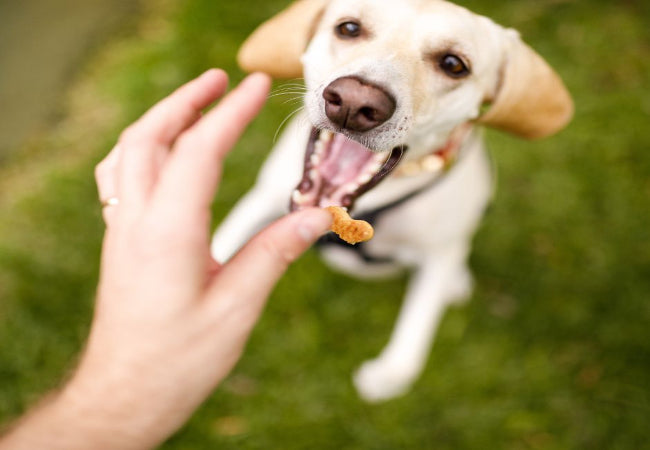Training vs. Bribing: Build Reliable Behavior Without Food 🐶✨

In this article
Training vs. Bribing: Build Reliable Behavior Without Food 🐶✨
By Dr. Duncan Houston BVSc
“My dog only listens if I have food.” Sound familiar?
I’m Dr. Duncan Houston. If you’re worried your dog has become “treat dependent,” this article will help you fix it. You’ll learn how to transition from using food as a bribe to using it as a reward that reinforces lasting behavior.
🧠 Bribing vs. Reinforcing – What’s the Difference?
- Bribe: Showing the treat before the behavior to lure action
- Reinforcement: Giving the treat after the behavior to strengthen it
Bribing: “Look what I have! Now sit!”
Reinforcing: Dog sits → “Yes!” → Treat appears from behind your back
Bribes teach dogs to perform only when they see a reward. Reinforcement teaches them that good things come after effort.
❌ Signs You’re Bribing Instead of Training
- 🍖 Your dog won’t respond unless they see the treat first
- 👀 They stare at your hands—not listen to your words
- 📉 They stop performing the behavior when your hand is empty
✅ How to Fix Treat Dependency
1. Hide the Treat
- 🎒 Use a treat pouch or keep the reward behind your back
- 🧠 Wait for the correct behavior, then reach to reward
2. Vary the Reward
- 🎾 Mix food with praise, toys, play, or access to a walk
- 🔁 Use high-value treats for hard things, lower value for basics
3. Delay the Reward Gradually
- ⏱️ Start with instant rewards, then increase delay 2–3 seconds, then 5–10
- 🎯 Teach your dog that staying engaged pays off
4. Use Intermittent Reinforcement
- 📉 Reward every repetition at first, then every second, then randomly
- 💡 Makes behavior more resistant to extinction (like a slot machine)
5. Reward the Behavior, Not the Movement
- 🧍 Wait until your dog is fully in a sit—not just beginning it
- 🧠 Mark the moment they’re still, focused, or calm
💡 Replace Food with “Life Rewards”
Real-life privileges can be powerful motivators:
- 🚪 Waiting calmly = access to outdoors
- 🦴 Sitting = release for a chew
- 🎾 Eye contact = throw of the ball
Rule: No free meals. If your dog wants something—ask for a behavior first.
🚫 What Not to Do
- ❌ Don’t stop treats cold turkey—this can create frustration or confusion
- ❌ Don’t go too long without reinforcing—dogs need feedback
- ❌ Don’t rely on praise alone at first—it takes time to build value
🎁 Woopf Tools to Support Clean Training
- Explorer Dual Pocket Dispenser – Keep high and low value treats ready while keeping them out of sight until earned
- Explorer Harness – Ideal for calmly training leash manners without tugging or food-based luring
- Bungee Lead – Reinforce calm walking naturally without constant reward loops
💬 What Dog Parents Say
“I was accidentally bribing. Once we started rewarding after and not before, training actually worked.” – Kelly & Bruno
“The Woopf dispenser made it easy to vary rewards and keep my dog guessing—in a good way.” – Marcus & Peppa
👩⚕️ Want Help Breaking Treat Dependence?
Send your current training routine to Ask A Vet and we’ll build a reinforcement schedule to transition you from treats to trust—with reliable behavior that lasts.
Final Thoughts
Training should motivate, not manipulate. When you reward thoughtfully, your dog listens not for food—but for clarity, connection, and confidence. Treats are tools—not crutches. Use them wisely, and you’ll build behaviors that last a lifetime.






